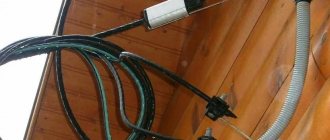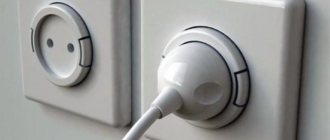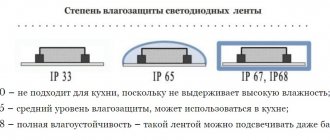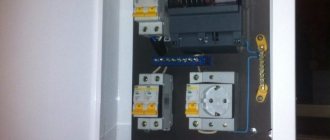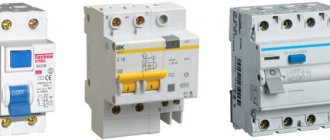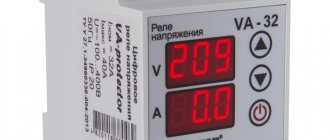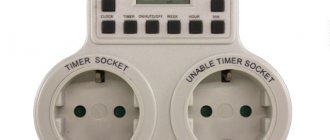Electrician in the house
Encyclopedia about electricity from A to Z
Masters catalog
Find the best master or company in your city
An example of wiring that needs to be calculated
Almost every true home craftsman has the skills of an electrician, so many do not trust anyone to install electrical wiring in a new house or apartment, but do it themselves. The first stage is to make a project and determine how much and what wire and accessories need to be purchased. We will try to tell you how to calculate electrical wiring in a house.
- Preparing the initial data What input will be: one or three phases
- Deciding how we will do the wiring
- Wiring type
- Drawing a wiring diagram
- What to consider when marking the location of wiring elements
- We determine consumers and loads
- We divide the wiring into sections
Diagram to help!
It is best and most accurate to carry out the calculation by first drawing up a diagram of the electrical wiring in the house.
The prepared project must indicate the following points:
- The exact number of sockets, switches and distribution boxes, as well as the height of their mounting and the method of connection to the network (through distribution boxes in the rooms or directly from the panel). Read more about the location of sockets in the apartment in the article: https://samelectrik.ru/pravilnoe-raspolozhenie-rozetok-v-kvartire.html.
- Installation locations for all lighting fixtures in the rooms: sconces, chandeliers and, most importantly, spotlights. By the way, before calculating the length of the cable for the electrical wiring, decide on the height of the ceiling. You must understand that the margin will be about 20 cm if the ceilings do not drop, and about 50 cm if the ceiling drops by 30 cm.
- The selected cable cross-section for the socket group, connecting powerful electrical appliances and lighting lines. For example, when designing lighting, wires with a cross-section of 3 * 1.5 mm2 are usually used, while sockets require a cable with more powerful conductors - 3 * 2.5 mm2. As for powerful electrical appliances, even to connect the hob, a cable with a cross section of 3 * 6 mm2 must be used (according to SP 256.1325800.2016 clause 10.2). As you understand, this is a very important point when calculating the length of the wiring, because... You will have to buy each type of wire separately in the required quantity. You can calculate the cable cross-section for power and current without any problems.
By the way, you also need to decide right away about connecting household appliances. Most likely, each group of electrical appliances will have to have a separate wire from the panel, and not just a new line from the distribution box in the room!
Having already prepared a visual wiring project, you can calculate how much cable is needed to supply electricity to a house or apartment. Of course, it would be ideal to immediately mark the walls and ceiling for wiring, and then simply use a tape measure to measure all the drawn lines and calculate the total number of each type of wire for the designed network, but, as practice shows, no one does this.
Additionally, you must make the following adjustments to the calculation that you may not have known about:
- Multiply the total number of wires by a factor of 1.1-1.2. This is a reserve that will not allow a situation where there are several meters short of the sockets and you have to go buy more material.
- For sockets and switches, leave a margin of at least 20 cm for connecting electrical wires.
- If you have not decided on the ceiling, it is better to calculate the reserve of at least 50 cm of cable for connecting the lamps.
- To assemble the distribution panel, the margin should be about 50 cm.
Using this principle, you can independently calculate the amount of materials for installing electrical wiring in a house or apartment. We will talk about a simpler calculation technology below.
Regulatory restrictions
Utility companies that provide electricity to the population have the right to impose restrictions on the maximum total power of appliances in an apartment. This can be achieved by installing electricity meters with a certain capacity.
The device is equipped with automatic disposable or reusable fuses, which operate when the threshold current value is exceeded.
Soviet-style electricity meters are being massively replaced with electronic ones. They are even more sensitive to overloads, due to which they quickly fail
If you remove the plugs from the meter and connect it directly to the apartment wiring, then it is guaranteed to burn out if the operating mode is disrupted for a long time. Most Soviet meters installed in apartments can withstand a peak load of 25 A for up to 1 minute.
After this, they are burned, which can lead to payment for the installation of a new device and a fine for violating operating rules.
The wiring in the entrance is also unable to withstand high loads; if it burns out, it can cut off power to several apartments at once. Therefore, when connecting an apartment to the intra-house network with a 2.5 mm cable, you should not expect that a thicker intra-apartment wire will be able to withstand high loads.
It is especially important to take into account the factor of regulatory restrictions at the stage of planning the installation of electric heating, heated floors, infrared saunas and other energy-intensive equipment. You must first consult with the relevant utility services about the possibilities of electrical equipment installed in front of the apartment.
You must first consult with the relevant utility services about the possibilities of electrical equipment installed in front of the apartment.
If you decide to calculate the electrical wiring parameters yourself, then it will be useful for you to understand such concepts as: current, power and voltage. Read more in the article - How to calculate power, current and voltage: principles and examples of calculations for domestic conditions
Option for the lazy
If you are too lazy to spend time designing your home network, you can use a simplified calculation of the length of conductors. This method, by the way, is used by many even professional electricians who, from their own experience, can calculate how much wire is needed for a particular object. The bottom line is that you need to calculate the amount of cable for electrical wiring based on the area of the room. It’s all very simple – take the area of a private house or apartment and multiply by “2”. This is approximately the length of cable products you need to carry out the wiring.
In addition to the fact that this is a “calculation by eye,” you should not forget about an important nuance - thus, you can only calculate the length of one of the lines (lighting or power). But you won’t be able to find out exactly how much wire you will need for sockets and how much for lighting.
In this case, again, it is customary to take products in a ratio of 1:1.5 - 1 part for providing light in the rooms, and 1.5 parts for sockets and connecting equipment. For example, if a house has an area of 100 sq.m., you will have to buy 200 meters for lamps and 300 for sockets.
Based on reviews from many forum users, including electricians, we can say that this option for calculating electrical wiring in most cases turns out to be correct. People write that, for example, for a one-room apartment with an area of 40 sq.m. 100 meters of cable was enough. At the same time, to supply electricity to a two-story cottage with a total area of 400 sq.m. it is enough to calculate 1 km of each type of wire. If the calculation is incorrect, it is better to buy a few tens of meters in addition than to overpay a fairly decent amount.
Finally, we recommend watching a video that outlines the calculation of the amount of materials for electrical installation:
This is how you can find out how much wire you need to power your home. By the way, if you decide to make open wiring, you need to calculate the length of the cable channels only based on the finished diagram. We hope that now you know how to calculate the amount of cable for electrical wiring.
Also read:
- Typical wiring diagram for a 3-room apartment
- Calculator for calculating cable cross-section
- How to calculate the number of spotlights
The length of the main power cable in a high-rise building is how many meters in a 10-story building
Calculating the length and cross-section of the main power cable in a multi-story building may be necessary when repairing electrical wiring. Thus, residents of old apartments often change the wiring in favor of a more powerful one. At the same time, the voltage on the power cable increases. Because of this, the cable heats up and becomes unusable. A reasonable question arises about replacing the main power cable in the entrance with a cable with a larger cross-section. The main problems that residents may encounter are obtaining permission from the utilities of the housing department or homeowners association, the queue for the repair team to fulfill the application, and the cost of the cable itself.
Since the main cable runs only from the ASU to the top floor, calculating its length will not be difficult: it will be equal to the height of the house, taking into account the necessary technological clearances.
For a ten-story building, the cable length will be about 35 meters. But all these preliminary calculations can only be used to calculate the estimated cost of the cable. The exact length and cross-section should only be obtained from employees of the relevant utility company to which your home belongs.
Cable cross-section
Before choosing a cable, you need to calculate the power consumption. The cable cross-section directly depends on this factor.
So, let's say that we have the following appliances in our kitchen:
— electric kettle 2.0 kW
— microwave oven 0.7 kW;
— refrigerator 0.7 kW;
2.0 + 0.7 + 0.7 = 3.4 kW
Consumption in the kitchen was 3.4 kW.
To convert to watts, you need to multiply by 1000: 3.4 kW * 1000 = 3400 W.
To find the current strength, we convert it into amperes using the formula: power divided by voltage (P / U = I) 3400 / 250 = 13.6.
The current strength is 13.6A.
Now it is necessary to take into account the demand coefficient, it takes into account the number of electrical appliances, in our case there are 3 of them, the coefficient values are as follows:
2 electrical appliances – 0.8
3 electrical appliances – 0.75
5 or more electrical appliances – 0.7
And so our coefficient is 0.7. Multiply by the resulting current: 13.6 * 0.7 = 9.52 A
Thus, the operating current in the kitchen was 9.52 amperes.
Knowing the operating current, we can safely select the machine and wires. You need to select them with a small gap. So a machine with a working current of 10A is suitable for us.
The cable is selected in accordance with the table of rules for electrical installations, the table is given below.
| Wire cross-section in mm² | Maximum permissible current for copper (A) | Maximum permissible current for aluminum (A) |
| 0,75 | 11 | 8 |
| 1,0 | 15 | 11 |
| 1,5 | 17 | 13 |
| 2,5 | 25 | 19 |
| 4,0 | 35 | 28 |
| 6,0 | 42 | 32 |
| 10,0 | 60 | 47 |
| 16,0 | 80 | 60 |
Based on the table, a copper cable with a cross section of 0.75 mm² is suitable for us
As mentioned above, the cable must be selected with a small gap, this is necessary to avoid overheating of the wires.
Also, when choosing a cable, the environment in which it will be used, as well as the operating conditions, plays an important role. For example, in rooms where flammable materials are stored (garage, warehouse, etc.) a cable with a non-flammable winding is used. In apartments, the cables most often used are PBPP, PVS - flexible, with multi-wire cores, or VVGng and VVG - rigid, with a single-wire core.
It is also not difficult to calculate the required cable length. This is why we initially asked to carry out the apartment plan taking into account the scale. The only caveat is that you need to add 15% to the resulting length - this is the standard margin.
The sequence of calculating the cross-section of conductors
Since we are calculating the wiring for our home, in our article we will try to cite and take into account other PUE standards relating to private households and apartments.
The main one for us is clause 6.2.2 of the PUE, which stipulates that in apartments and houses all group lines must be powered by circuit breakers with a current of no more than 25A. Based on this, the wires for powering such group networks should not be designed for a higher current. The only exception is the calculation of power input wires to the apartment.
Rated power calculation
Based on all of the above, the main criterion for us is the power of devices connected to the network. That is why the calculation should start with the total load.
First of all, we consider powerful consumers, such as: air conditioners, electric furnaces, electric heaters and boilers. If the power of such devices exceeds 1.5 - 2 kW, then it is advisable to consider their power supply with a separate line.
So:
If you do the calculations yourself, it is advisable to separately calculate the total power of electrical appliances and the lighting network.
The photo shows the rated power of various electrical appliances
- If you have powerful household appliances, do not take them into account when calculating the total power. We will allocate a separate line for them.
- When calculating, assume that the most powerful electrical appliance is connected to each outlet. At the same time, low-power video and other household appliances can be rounded off. The main thing is not to count the same device twice.
- In most cases, the total load will be about 3-5 kW for each living room. Don't be scared by these numbers.
- If the number of sockets in the apartment exceeds 10, then the total load, according to clause 4.4 of VSN 59-88, is multiplied by a correction factor of 0.9. If there are more than 20 sockets, by 0.8.
Rated current calculation
Since we only have a formula for calculating the current cross-section of a wire, we convert the power into rated current.
To do this, we use the formula: I=P/U×cosα, where I is our rated current; P is the total power received from us, U is the rated voltage of the network (for a single-phase network 220V, for a three-phase network 380V); and cosα is the power factor.
If you find it on all devices, you can get the total power factor by multiplying. Or we can neglect it and take it equal to one, this will create a certain margin for our calculations.
Let's give an example. Let's say our total power is 10 kW. Taking the power factor equal to unity, for a single-phase network we obtain a rated current equal to 45.45A.
Summary table for selecting wire cross-section by rated current
But as we have already noted, electrical appliances in the apartment should be powered from circuit breakers with a current of no more than 25A. Therefore, in our case, we divide the loads into two groups, powered by 25A machines, or into three groups, powered by 16A machines. Here the price of materials and convenience become decisive, so freedom of choice opens up before us.
Impact on the calculation of other parameters
But the calculation of the current cross-section of the wires does not end there. Now we need to take into account all the additional parameters and possible laying conditions.
So:
- If it is intended that your wires will be arranged in bundles, then correction factors should be applied to the rated currents indicated in the tables. So, according to clause 1.3.10 of the PUE, if the number of wires in a bundle is more than 4, then the coefficient will be 0.68. If more than 6, then 0.63, if more than ten, then 0.6.
- If it is assumed that the wires will be laid indoors or outdoors, where the average temperature differs from +15⁰С, then you should use the temperature correction coefficients from Table 1.3.3 of the PUE.
How to determine the cross section in practice
The method for calculating the conductor cross-section in practice involves two stages:
- Calculation of the total power of all electricity consumers in the house using the formula: P = (P1+P2…+…Pn)×K×J, where P1+…+Pn is the power of each electrical appliance, K is a coefficient (dimensionless) indicating the percentage of equipment involved (of the total number of cash in the house), J – power reserve factor (usually J = 1.5... 2).
- Determination of the section from the table.
In the above formula, the coefficients are determined through practical research. In particular, K usually does not exceed 0.8 (80%). This means that the equipment in the house is not used at the same time. In fact, you wouldn’t turn on the air conditioner and heating device at the same time.
The power reserve (J) also needs to be taken into account for the future. After all, energy consumption is growing every year. If growth is not taken into account, then after a few years reinforcement of the wiring may be required.
Having calculated the total power of all consumers using the formula, it is easy to determine the required wiring cross-section from the table.
Computations
We have collected all the necessary data, one might even say, we have made initial calculations, since we already know the total footage of the wire we need. It remains to calculate its cross section.
We divide the wiring into sections
But we will not count each section separately, that is, from each branch to the device for the following reasons:
Therefore, we will approach one of the following methods:
Calculation of wire cross-section
We know the power of the devices, but we need to calculate the current passing through the wires. For alternating current, the formula is derived from the formula for calculating power: P=U×I×cosφ
Therefore, we calculate the load (power) current using the formula: I = P/(U×cosφ).
Everything is clear except cosine phi. Its value for most modern household appliances is 1, so many recommend neglecting it.
However, for some consumers, in particular those with a powerful electric motor (for example, in a refrigerator, various machines in a home workshop), it can even be 0.5-0.6. Since it is located in the fraction divider, the current increases, so it still needs to be taken into account. You can find out the value from the device passport.
Having calculated the currents for different sections of the network, you can select wires. To do this, we will use the table below. You can also use online calculators, find data on how to calculate the cross-section of electrical wiring in reference books and the Internet.
mm2
Let us make the necessary clarifications:
Do you need power reserve?
If the apartment is equipped with everything necessary, then when calculating the wiring, you don’t have to use it. Since in the tables for selecting a section it is most often already included.
how to cover the corners of walls with wallpaper
In addition, in the future, the power consumption of household appliances is unlikely to increase; the trend, on the contrary, is leading to new developments reducing energy consumption. But if necessary, it can be taken, as a rule, no more than 10%.
Ground wire
Typically, three-core cables are purchased for a single-phase network, and four-core cables for a three-phase network. They already have a grounding conductor (you just need to connect it correctly). If you plan to purchase cables other than these, then according to the rules we take the cross-section of the grounding conductor to be at least half of the cross-section of the power conductors.
Protection devices
The calculations do not end with the fact that we were able to calculate the cross-section of the electrical wiring and the length of the cables. It is also necessary to find out the response currents of the protective devices that are mounted at the input. In order not to recalculate the power again, we take it to be 10-15% more than the maximum current flowing through the conductor connected immediately after the input (metering device); if we took a reserve, then we take it into account.
Method for determining the cross-section of home wiring
When calculating the cross-section of an electrical cable when installing home wiring, many factors are taken into account. There are special computer programs that allow you to take into account all the features of the house and the needs of its residents. But you can determine the cross-section required for wiring yourself using the described method.
It is important to understand that the diameter of the wires in the apartment may differ from room to room. At the entrance to the electric meter there is only one; at the distribution box the wire cross-section may already be smaller, at sockets and lamps - even smaller.
At each section of electrical wiring, it is advisable to determine the parameters necessary for it, so as not to overpay for excessively thick wires.
If you do not want to calculate the cross-section of the wiring being laid, you can use the recommendations of experienced electricians who claim:
Despite the recommendations of PUE 7.1.34 to carry out calculations for all power lines, practical experience shows that in most cases standard values can be accepted. As a rule, lighting branches in apartments and houses are laid with 3x1.5mm² cable. The maximum power is 4.1 kW. The machine is installed on the lighting branches with a nominal value of 10A. Power supply lines for plug sockets are laid with 3x2.5mm² cable. The maximum power is within 5.9 kW, a circuit breaker with a rating of 16A is needed. To ensure the connection of powerful consumers, such as an electric stove, oven or MKCh, a 3×6mm² cable is used. Maximum power up to 10.1 kW. A machine is needed with a rating of 32 A. To enter the electrical network into a house or apartment, use a cable with a cross section of 3×6mm². However, now, due to the increase in powerful consumers in housing, cables with a cross-section of 3×10mm² are increasingly used for input. The most suitable cable for home wiring is VVGng-LS. It contains a slight inclusion of halogens, which create a hazard when smoldering. Cables marked VVG and VVGng are prohibited for installing an electrical network in a house or apartment. Their insulation is made of PVC, a polymer that releases a large amount of toxic substances when burning/smoldering. It is prohibited to construct electrical wiring from PVC-insulated cable due to the significant halogen content. Smoldering wire insulation with low content allows people to evacuate without getting seriously poisoned. The PPGng-HF cable is considered the safest for the life and health of residential property owners. Its insulation contains no halogens at all.
How to properly install electrical wiring
If you decide that you can handle the correct electrical wiring in your apartment, then first you need to choose the type of wiring that suits the needs of the homeowners. There are three types of wiring:
- using distribution boxes;
- star;
- plume.
Now you need to draw up a plan for the electrical wiring in the apartment in two copies (on the first one you should draw a plan for the location of switches and lighting equipment, and on the second - sockets).
After this, the clients of the electrical circuit should be divided into groups. It might look like this:
- first group – refrigerator and hood (25 A automatic);
- the second is a washing machine (25 A);
- third - lighting fixtures (10 A);
- fourth - sockets (25 A);
- fifth – dishwasher (25 A);
- the sixth is an electric stove (32 A).
Or like this:
- lighting fixtures for living quarters, kitchen and hallway (10A automatic);
- sockets in living rooms (25 A circuit breaker);
- sockets in the kitchen and hallway (25 A circuit breaker);
- lighting fixtures and sockets in the bathroom (these clients are combined into one group because they work in a humid environment and have serious requirements);
For each household equipment, one group is allocated with a 25 or 32 A automatic machine. The equipment is divided into groups due to some nuances.
If all the equipment that consumes electricity is connected to one machine, then you will need a very thick cable that can withstand such a load. You will also have to buy an automatic machine designed for high power, and this will be quite expensive.
If one of the network elements breaks down, you will have to turn off the power to the entire apartment in order to begin restoration work.
When the electrical wiring diagram for a one-room apartment is ready, it is necessary to determine the number of all electricity consumers. You will have to calculate the required number of outlets based on the number of electrically powered equipment you already have, as well as taking into account future purchases.
Then you need to correctly position all sockets and switches. To do this, use the following tips:
- switches and sockets should be placed to the left of the door;
- in living rooms and hallways, sockets should be at a height of 0.4 meters, in the kitchen at a height of 0.95 -1.15 meters;
- switches should be located at a height of 0.9 meters;
- It is necessary to mark the locations of switches and sockets in the diagram.
Then you should run the wires from the switches and sockets (meaning the plan). If you are connecting via distribution boxes, then all cables must first go to them, and then to the electrical panel. For correct wiring you need to follow some rules:
- cables must run strictly horizontally or vertically;
- It is better to avoid crossing wires;
- the cable must be installed at a distance of 0.15 meters from the ceiling and 0.1 meters from doors and windows;
- the cable to the switch is fed from above, the cable to the socket from below.
The last step will be to calculate the cable footage and the total number of machines. When calculating cable footage, it is necessary to take into account the dimensions of the rooms, and when calculating the number of machines, one must proceed from the number of groups. You should also remember that all machines are ultimately connected to one, which is designed for high power. If you use and plan to purchase a stove that is powered by electricity, then you need an automatic machine that is rated at least 63 A.
Return to content
Voltage drop calculation
Not only the degree of heating of the core, but also the electrical voltage at the far end of the wire depends on the cross-section of the electrical cable. Household appliances are designed for certain parameters of the electrical network, and their constant discrepancy can lead to a reduction in the service life of the equipment.
If the voltage drops on the boiler, it is advisable to install a stabilizer so that the equipment does not experience additional loads due to inconsistencies in the operational characteristics of the electrical network.
As the cable lengthens, a voltage drop occurs. This effect can be reduced by increasing the wire cross-section. It is considered critical to reduce the voltage at the end of the wire by 5% compared to its value at the current source.
This indicator can be calculated using the well-known formula:
Upad = I*2*(ρ*L)/S,
Where:
- ρ – metal resistivity, Ohm*mm2/m;
- L – cable length, m;
- S – conductor cross-section in mm2;
- Upad – drop voltage, Volt;
- I – current flowing through the conductor.
If the calculated voltage drop is more than 5% of the rated voltage, then it is necessary to use a cable with a larger cross-section. This will ensure stable operation of the equipment.
Heating boilers, washing machines and other devices with many relays and sensors are especially sensitive to voltage values. This feature must also be taken into account when using carriers.
Where does the electrical wiring calculation begin?
Scientists still have a rather vague idea of what current is. It is known how to use it, it is known how to change it, how to direct it, but all its properties and features have not been solved. However, today it is impossible, or very difficult, to do without a stream of electrons running along a cable, especially for those who are accustomed to comfort. Light, heat, fresh conditioned air, communications, and often cooking - all this provides us with electricity, which powers all kinds of household and industrial equipment. In order for current to start flowing into a house or area, it is not enough to simply stretch the wires; you need to know exactly what material they should be made of and what cross-section. But let's take things in order.
How to calculate electrical wiring on a site
In the local area, along the paths, sometimes even in the garden and flower bed, as well as along the perimeter of the site, there is always some kind of lighting. And if some particularly economical owners find it more convenient to use solar-powered lanterns and decorative lamps, then traditionally power lines from the nearest substation are stretched to the land plots. This can be an overhead cable or underground; in the first case, it passes through insulators on the tops of the poles, and in the second, through a special dielectric pipe buried deep in the ground.
Based on how electricity is supplied, it is necessary to calculate the continuation of the line on the site. The simplest solution is from two wires, one of which is phase and the other neutral, sometimes a house may have three wires to provide two separate phases. A four-wire input is necessary if there is a need for a three-phase version, if there is an appropriate consumer (industrial and professional equipment, machine tool). The latter type of connection can only be used after obtaining permission from the electricity supply organization.
So, let's focus on a single-phase two-wire connection to the substation, which still needs to be extended if you do not want to pay for the work of specialists. Before calculating the electrical wiring, you should take into account that the length of the cable from the common line to your site should not exceed 25 meters; at a greater distance (and in case of strong winds in your area and at a shorter distance) you need to install a support. The height of the cable above the road is at least 6 meters; it is advisable to install an overhead line into the house at a level of 3 meters.
At the output from the substation where the transformer is located, the current usually already has a voltage of 220 V. But drops in the electrical network are common, and it may turn out that some 160 V is coming to you. To obtain the required voltage level, you need to install a stabilizer, as well as circuit breakers that will protect the network from overload. Their parameters are indicated in Amperes, that is, they are measured against current consumption. Having completed the distribution panel, we place it in a place where there is no dampness.
Wires are extended to all outbuildings, be it a barn or a summer shed; this can be done by air or directly, which will be more economical. It is better to provide lighting along the paths with an underground cable, and the lights should be connected in parallel rather than in series, so that the burnout of one lamp does not turn off the entire circuit. We take a plan, and on it we mark the overhead line connecting the buildings with the distributor, and the underground cable stretching from it along the paths (and repeating all their bends). We measure the resulting wiring and multiply its length by 2, since at least two wires are needed (double insulation is recommended outdoors), for phase and zero.
What affects the heating of wires
If the wiring heats up during the operation of household appliances, then you should immediately take all necessary measures to eliminate this problem. There are many factors influencing the heating of wires, but the main ones include the following:
- Insufficient cable cross-sectional area. To put it in accessible language, we can say this: the thicker the wires of the cable, the more current it can transmit without overheating. The value of this value is indicated in the marking of cable products. You can also measure the cross-section yourself using a caliper (you should make sure that the wire is not live) or by the type of wire.
- The material from which the wire is made. Copper conductors transmit voltage better to the consumer and have lower resistance compared to aluminum conductors. Naturally, they heat up less.
- Type of core The cable can be single-core (the core consists of one thick rod) or multi-core (the core consists of a large number of small wires). A multi-core cable is more flexible, but is significantly inferior to a single-core cable in terms of the permissible strength of the transmitted current.
- Cable laying method. Tightly laid wires located in the pipe heat up noticeably more than open wiring.
- Material and quality of insulation. Inexpensive wires, as a rule, have low quality insulation, which negatively affects their resistance to high temperatures.
Calculation of wiring outside the home
If you live in a private house, you have probably thought more than once about how you can decorate your garden space. One option is to install outdoor lighting fixtures. Some people use flashlights with solar panels, while others run electrical lines. The wire can be laid either deep underground, using dielectric pipes, or above it.
There are several types of connection:
- single-phase;
- two-phase;
- three-phase.
Electrical wiring on the site directly depends on the type of supply from the house. In most cases, a two-wire system is sufficient for minimal electricity consumption. One will be a phase, the other will be a zero. There are situations when three wires are needed to connect the cable from the house to the site. The third plays the role of the second phase. If you have a power source on your site, such as a transformer or machine, you will need to use a three-phase wiring method. Such a four-wire input is permissible only after the appropriate permission from the organization that supplies you with electricity.
Let's consider a single-phase two-wire connection on a house site.
First, let's give a few recommendations:
- Before starting calculations, it is necessary to take into account the length of the cable. If the distance from the source to the site exceeds 25 meters, then it will be necessary to erect additional fastening for the wire. If your area experiences significant winds, then this distance should be reduced to 15–20 meters;
- if the cable passes over the roadway, its height must be at least 6 meters above the ground;
- It is recommended to connect the line to the house at a height of at least 3 meters.
As you know, current leaves the transformer at a voltage of 220 V. But there are situations when voltage drops occur, and much less can reach you - about 150 V. Stabilizers are created for this. They are installed where electricity comes out. Also equip the system with network overload protection circuit breakers. The distribution panel must be located in a dry place.
You can lay the wire both underground and directly through the air. The latter option will be much more economical. In the case of lanterns along paths, it is better to get by with underground cable laying. Light bulbs must be connected in a parallel circuit. This way you will exclude the possibility of the lack of all lighting as a result of one of them burning out.
To perform a wire calculation, take a site plan and mark all underground and overhead electrical transmission lines. Sum up their lengths and multiply by two. This is necessary because you will need two wires.
Input wire
An example of connecting an input to a private house
- Although this does not directly concern the calculation of electrical wiring, still complete this step. Check the cross-section (or the sum of cross-sections, if you have several lines) of the wires after input with the cross-section of the input conductor.
- The input must either be made with a wire of a larger cross-section or be equal. If the opposite happens, then you need to reduce your appetite (the power of the appliances installed in the house), or contact the electricity supplier company.
- A situation may occur when correctly calculated internal wiring will withstand but the input will burn out. Therefore, it is necessary to increase its diameter and permissible current. This can be done by a service serving external networks.
Usually this is a paid procedure and at the same time it is necessary to renew the contract due to an increase in the limit of supplied energy.
Correct calculation of wiring will help to avoid frequent repairs.
I hope our article has fully covered the topic for you: calculating electrical wiring in a house. Even if you do not carry out this work yourself, knowing the principles will help you save money when ordering materials or services. May your home always be illuminated, comfortable and safe.
Calculation of electrical wiring in the apartment
First of all, you need to remember that the calculation of electrical wiring in an apartment begins with drawing up a wiring diagram.
If you decide to do the wiring yourself, you need to pay special attention to the following issues:
- determination of the cross-section of wire cores;
- under what conditions the wire will be laid;
- how to connect the meter;
- grounding;
- total power of devices;
- power grid protection.
An average one-room apartment requires a total power of 15 kW. It is more convenient to calculate power consumption if you conditionally divide the wiring into several groups.
For example, sockets for:
- bathroom;
- rooms;
- kitchens;
- corridor.
And separately take into account the lighting of the apartment. This will make it easier for you to calculate the maximum load of electrical appliances in your home. If in doubt, use a special calculator that you can find on the Internet in construction forums.
Also, when calculating the wiring, try to determine as accurately as possible the total power consumed by all large electrical appliances in the apartment. To do this, you will need the information that the manufacturer provides in the instruction manual or on the boxes. You can also find additional information on the Internet.
As you can see, you can calculate the electrical wiring yourself. Remember to be precise in any calculations. If you have encountered such calculations, please share your comments under this article.
An example of an apartment power supply project
Back
Forward
For convenience and safety, all electrical wiring must be divided into groups, each group will be connected to a separate circuit breaker on the electric meter. First of all, this will protect the network from possible overloads and failures; if, for example, for some reason, the socket in the kitchen is short-circuited, then the appliances in the rooms will not be damaged due to a surge in electricity. It is also convenient for repairs. By changing switches in one room, you do not have to turn off the power to the entire apartment; the sockets remain connected to the network.
The division into groups can be done as follows:
- sockets in the room;
- sockets in the kitchen;
- sockets in bathtubs;
- sockets in the corridor;
- lighting.
To supply energy to the kitchen, it is necessary to take into account the fact that the largest consumers are located here - the refrigerator, microwave oven, oven, kettle, etc. Also, special attention will need to be paid to the automatic machine for the kitchen.
In principle, there should be no sockets in the bathroom, due to the humid environment of the room. The water heater and washing machine are usually connected directly to the circuit breakers on the meter. There may be one socket for a razor, but it is mounted in a special way and connected to a separate transformer.
Installing a ground loop
Any private house must be equipped with a grounding loop, which performs several tasks:
- Protects the inhabitants of the house when voltage appears on the device body.
- Supports the safe operation of appliances operating in a damp environment (washing machines and dishwashers, electric stoves, boilers and instantaneous water heaters).
- Reduces the level of noise (interference) in the electrical network.
The circuit is installed in the ground next to the house; Inside, the grounding is connected to the electrical panel. It is required for:
- high power electrical engineering;
- light sources (circuit groups) in bathrooms.
Installation of distribution board
Example
For example, let’s calculate the electrical wiring in an apartment for a new washing machine. For example, I chose the Bosch WAN20060OE washing machine. Its maximum power consumption is 2300 W (as described).
For the washing machine you need to make a separate group with its own circuit breaker and RCD. A separate protection group means that the washing machine socket must be powered by an electrical cable coming from the apartment switchboard and protected by a separate circuit breaker and, preferably, a separate RCD.
Current calculation:
We divide 2300 W by 220 Volts and get a circuit current equal to 10.45 Amperes. Here we round down, since the voltage can be 220-230 V.
We select a circuit breaker with a reserve of 16 Amps. We select the RCD for an operating current of 10 or 16 Amperes. The RCD response current is 30 mA.
To improve the ergonomics of the shield, it is better to replace the circuit breaker + RCD pair with a differential circuit breaker (difavtomat). It will perform both protection functions. The rating of the differential circuit breaker is 16 Amperes.
We measure the length of the required cable with a tape measure from the installation site of the socket to the installation site of the circuit breaker. Add 10% to this length.
That's it, the electrical wiring in the apartment for the new washing machine has been calculated.
Installation and switching of cables and structures
Electrical wiring in the house is connected to each other using the following method:
- Soldering. Soldering is not used for in-house installation; it is an expensive and labor-intensive process.
- Twisting. The easiest way to install wires from the same material. Copper and aluminum cannot be twisted - the connection will heat up.
- Connections on terminal blocks. Reliable, simple and inexpensive installation method. Terminal blocks of various types, shapes, types and sizes greatly simplify installation.
Simplified method
If you do not have a ready-made wiring project and you think that you do not need it, you can use a simpler method to calculate the cable length. Even professional electricians often use this method.
In this case, we calculate the amount of cable by simply multiplying the area of the apartment or house by “4”. That is, for installing electrical wiring in an apartment with an area of 75 sq.m. we will need 4x75 - 300 meters of cable. This is, as they say, “the hospital average.” If we are talking about a large house, “stuffed” with household and digital appliances, then you can even multiply by “5”. But for a small one-room apartment, a coefficient of “3” will be enough.
However, this method allows you to find out only the total length of the wiring. But what if you are going to use different brands of wires for lighting and power lines? In this case, the number of each cable is calculated in the ratio of 2 to 3. That is, continuing the example above, out of 300 meters of cable, 120 meters will go to lighting lines, and 180 to socket lines.
Our contacts
Trading House "Yugtelekabel"
350051, Russia, Krasnodar, st. Neftyanikov Highway, 37/3
Source
Installation of distribution board elements
After the electrical connection diagram for a private home has been selected and consumers have been divided into groups, a distribution board is installed. It contains:
- circuit breaker and RCD – general;
- automatic machines and RCDs – for designated groups;
- counter;
- zero bus and main ground bus.
On a panel, the function of a core can be determined by the color of its insulation:
- white (sometimes red, black or brown) corresponds to phase;
- blue – zero;
- yellow-green – protective grounding.
The final distribution board for electrical wiring in a private house is assembled after the installation of the wiring is completed.
Applicable wire colors
General rules for connecting to the electrical network
Following the installation of electrical wiring, automatic devices, RCDs and electrical appliances are installed. To commission the electrical equipment of a private house, a specialist from the energy supervision authority is invited, authorized to conduct acceptance tests.
After checking the safety of the electrical installation, a “Connection Certificate” is issued, allowing further use of the equipment. Based on this document, the energy supply organization enters into an agreement with the owner of the house and connects the home to the support.
The video shows how to connect electrical wiring:
Installation of electrical wiring of closed and open type
Wiring in a new house is installed in two ways - open and closed, and the first option is often chosen when it is impossible to use the second.
- Open wiring. It is laid over the walls and, if desired, protected by cable ducts. It has its advantages - it is always available for inspection. At the same time, like any technical element in the interior, it “hurts the eye.” The exception is the design of premises in a loft or retro style, where such solutions are welcome.
In open installation, the cable is fastened with staples to the surface, then it is covered with a box. Recesses for sockets and switches are made with a hammer drill or drill.
Box (cable channel) for open wiring
- Hidden wiring. With hidden installation, you have to groove the walls (punch through channels), lay wires and hide them behind the wall trim. This method is more reliable and durable, but at the same time labor-intensive and costly for future alterations. To avoid touching cables in the future when drilling into walls, it is worth stocking up on a network layout plan.
Electrical wiring in the house is done according to the same rule: installation is carried out strictly horizontally or vertically, any other path is not allowed. Bends are made at right angles.
Before installation, walls, horizontal and vertical sections are marked in accordance with the diagram. This can be done using a laser level or a plumb line greased with chalk or charcoal. You can take pictures of walls with markings applied. This reminder will help you avoid touching the wiring with a drill or nail in the future.
You need to sketch out the layout of the wires inside the walls
During hidden installation, grooves (grooves in the surface of the wall) are punched with a chisel or grinder or a special wall cutter. The wires are laid in grooves, they are secured and masked with plaster or alabaster. Sometimes hidden wiring is carried out not in a groove, but under the baseboard, which preserves access and the possibility of inspection.
Review of common design mistakes
Defects in the design or planning of work entail installation errors, and this threatens disruptions in the functioning of the electrical network. The result may be the failure of expensive equipment, and even worse, an electrical injury to one of the residents.
What mistakes should you avoid:
- use low-quality products without labeling and certification;
- make one-to-one calculations - any technical products and materials must be purchased with a reserve;
- include in the project the installation of conventional sockets for connecting hobs, boilers, heat guns;
- in wooden houses, plan to use closed wiring - more complex and subject to the list of requirements of the PUE;
- design switching of low-voltage and high-power power wires in one distribution box;
- plan to connect wires using twists that are dangerous for further maintenance and operation; the best option is ready-made terminals;
- make circuits from aluminum and copper wires, and also use aluminum wiring.
Some errors relate to incorrect calculations. For example, grooves under the cable with a closed installation method should be laid to a depth of 2-2.5 cm, no less.
It is incorrect to place distribution boxes at the bottom or at human height. Their place is under the ceiling, 20 cm from a suspended structure or concrete ceiling slab
You cannot connect the grounding of sockets using a cable, or ground them on cast iron sewer or steel gas pipes.
If you do not know how to properly install electrical wiring in your home, contact the design organization. Specialists will visit the site and draw up a wiring diagram based on specific installation conditions.
Preparing the initial data
To calculate we need to know:
This issue is best dealt with, of course, by the owner, and not by the designer. The latter often does not even spend time on full-scale measurements or studying house drawings.
They take just three steps:
That's it, for them the calculation of the amount of wire for electrical wiring is over. This is roughly why numerous online calculators that are easy to find on the Internet work on the same principle. But by preparing the calculation for ourselves, we can make it more accurately, so there is no need to waste time, but we will calculate everything thoroughly.
What kind of input will there be: one or three phases
The question is not raised if the connection to the housing has already been made. But more often the wiring is done before connecting the communications. If we are talking about a city apartment, then it is clear that three phases do not make sense. For a cottage, this option needs to be considered.
It is beneficial only in two cases:
In other cases, three phases are unnecessary. In addition, meters, automatic machines and RCDs (residual current devices) that need to be installed at the input are obviously more expensive and more expensive for three than for one phase.
Deciding how we will do the wiring
Several options are possible:
Wiring type
There are two types of wiring, open and hidden:
By the way, the calculation of electrical wiring in a wooden house, although some of it may be open, is also done using this method. Safety rules require that all wires in combustible structures run in a pipe.
wall with Tsoi in Moscow
Drawing a wiring diagram
Next, we need to determine where the sockets, switches, lamps, and junction boxes will be located. You can draw on paper, but another way is more profitable - we mark it directly on the walls.
For marking, choose either a pencil or an erasable marker so that you can correct mistakes.
Thus, we achieve the following advantages:
In addition to measuring the length of the wires, we can immediately measure the required footage of pipes for laying in walls or boxes for external wiring. At the same time, we can calculate how much and what kind of fasteners we will need.
But this footage does not take into account the connections inside the wiring elements. Therefore, when calculating the electrical wiring in a private house, we add 20 cm to each socket, switch and distribution box. In addition, we add 10% of the total reserve.
What to consider when marking the location of wiring elements
When marking, we take into account the following; any design instructions take this into account:
Having completed this most labor-intensive work in the calculation, we already know how much wire we need, but we still don’t know which one. We also need data about current consumers that will be connected to our wiring.
We determine consumers and loads
For this stage, we can take a ready-made diagram that we have just drawn. We walk through the rooms and see what and where we will have it connected.
Moreover, taking into account the future, maybe now in our kitchen we only have a multicooker and a microwave, but when we get richer we are going to install a dishwasher, a coffee machine and a large TV. We also note the power of the lamps.
If you find it difficult to determine the power, this plate will help you:
| electrical appliance | Average power, kW | electrical appliance | Average power, kW |
| TV | 0,3-0,4 | air conditioner | 1,5-2 |
| Printer | 0,5-0,3 | instantaneous water heater | 1,5-1,8 |
| Personal Computer | 0,8-0,6 | DHW cylinder | 1,5-2 |
| hair dryer | 1-1,1 | electric drill | 0,5-0,8 |
| electric iron | 1,6-1,8 | hammer drill | 1200 |
| kettle | 1,2 | sharpening machine (emery) | 0,5-1 |
| fans | 0,5-1 | a circular saw | 1,3-2 |
| toaster | 0,8 | electric plane | 0,5-1 |
| coffee maker | 0,9-1,1 | jigsaw | 0,5-0,7 |
| vacuum cleaner | 1,8-1,5 | Grinder | 1,2-1,7 |
| oil heater | 1,5-2 | jointer (thicknesser) machine | 2,0-2,5 |
| microwave | 1,4-1,6 | compressor | 1,0-2,0 |
| electric oven | 2,0-2,1 | electric lawn mower | 1,0-1,5 |
| electric stove | 2,5-3,5 | welder | 2,0-3,0 |
| fridge | 0,8-0,6 | minitower | 0,8-1,2 |
| washing machine | 2,0-2,5 | chain saw | 0,8-1,5 |
Having determined how much and what we will have connected, we can move on.
